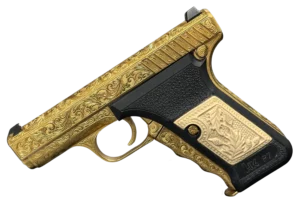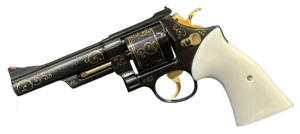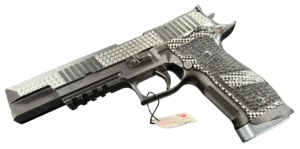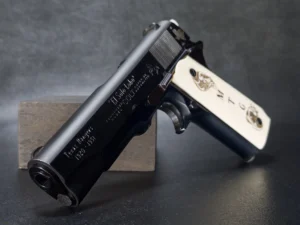Key Takeaways:
- The .38 Super didn’t just keep up—it quietly rewrote the rules: Born out of a need for more stopping power during the Prohibition era, the .38 Super carved a unique space for itself with blazing-fast muzzle velocity and barrier-defeating power. It wasn’t loud about it, but it showed up, worked hard, and stuck around longer than most of its rivals.
- From cops to competitors to collectors, the .38 Super found its way into every niche: What started as a law enforcement tool ended up becoming a favorite among competitive shooters for its flat-shooting performance, and a prized piece for collectors who appreciate Colt craftsmanship and the 1911 heritage. It’s not often a cartridge gets to wear that many hats—and wear them well.
- The 1911 in .38 Super is proof that some things don’t need to change—they just need the right company: Pairing Browning’s timeless platform with a high-velocity round gave shooters the best of both worlds: old-school reliability with new-school performance. Even today, it’s a platform that feels personal—something you can build on, brag about, and trust with every shot.
When you think of iconic pistols, there’s a good chance the 1911 comes to mind. With its clean lines, rugged feel, and unmistakable silhouette, it’s more than just a firearm—it’s a piece of History. But there’s one particular version of this legendary sidearm that often flies just under the radar despite its impressive resume.
Let’s talk about the 1911 chambered in .38 Super.
This isn’t some niche offshoot. Colt rolled out the .38 Super in 1929, taking the existing .38 ACP cartridge and giving it a serious jolt in velocity and performance. Why? Because law enforcement was facing increasingly tough odds—think car-riding gangsters in metal-bodied vehicles and early bullet-resistant vests. Officers needed something with a real punch.
The .38 Super didn’t just meet expectations—it rewrote the rulebook. It was the first pistol cartridge to break the 1,000-feet-per-second muzzle velocity barrier, a landmark in handgun ballistics. And it wasn’t just about speed; it could punch through barriers that other rounds bounced off.
Built on the bones of the already beloved 1911, the .38 Super variant added a new layer of capability to an already rock-solid platform. Over the decades, it’s been embraced by competitive shooters, self-defense advocates, and collectors alike.
In this article, we’re going to follow the trail of the 1911 .38 Super, from its bold beginnings to its place in modern firearms culture. We’ll touch on what makes it tick, why it was built the way it was, and how it’s evolved over the years.
Whether you’re a longtime gun owner, new to the hobby, or just someone with a curiosity for American ingenuity, this story is for you.
So, let’s rewind to the late 1920s, where it all began.
Born for a Purpose: The Origins of the .38 Super
It’s 1929. The world is on the cusp of economic collapse, Prohibition is still fueling the rise of organized crime, and law enforcement is desperately looking for more effective tools to do their job. Revolvers are solid, sure, but semi-autos are on the rise—and they need better ammo to keep up with real-world threats.
Enter Colt’s .38 Super. It wasn’t just marketing flair. Colt took the aging .38 ACP, cranked up the chamber pressure, and delivered something that hit harder, faster, and farther than anything in its class. This wasn’t about incremental improvement—it was a leap forward.
The goal was simple but ambitious: make a cartridge that could punch through car doors and crude body armor. What Colt came up with was the first semi-auto pistol round capable of delivering over 1,000 fps at the muzzle. That kind of speed gave it a serious bite.
Why did it matter? Because bullets that stopped at the car door weren’t cutting it anymore. The .38 Super could go through metal, through soft vests, and still have enough juice to do damage on the other side. For law enforcement, it wasn’t just helpful—it was essential.
And Colt was smart about the platform they chose to chamber it in. They dropped it into the Colt Government Model—a civilian version of the battle-tested M1911. It was already known for being rugged, reliable, and easy to shoot. Mating it with the new high-pressure round just made sense.
The end result? A new kind of fighting pistol that could take on the challenges of the era. One that combined old-school reliability with new-school performance. The .38 Super wasn’t just fast—it was trailblazing.
It also quietly set the tone for what would come later. You could argue that the .38 Super was the godfather of modern high-velocity pistol rounds. It proved that semi-autos could do more than just cycle quickly—they could hit hard, too.
The Man Behind the Machine: John Moses Browning and the 1911 Platform
Let’s take a moment to talk about the man behind the metal—John Moses Browning. If you’ve spent any time around firearms, his name carries serious weight. He’s the mind behind a staggering number of iconic guns, but the 1911 is arguably his crown jewel.
When the U.S. military adopted Browning’s 1911 pistol in—you guessed it—1911, it was a big deal. This was no gimmick. It was a rugged, no-nonsense design built for war. Solid steel frame. Reliable recoil operation. A trigger that felt just right. Soldiers loved it, and so did civilian shooters once it hit the market.
Now, fast-forward to 1929 when Colt wanted to roll out the .38 Super. They didn’t need to reinvent the wheel. The 1911 platform was already tried and true, and it was more than capable of handling the extra pressure the new cartridge brought to the table.
That’s the beauty of Browning’s design—it was flexible. With only minor changes, it could accommodate different calibers and applications. When Colt needed a trustworthy home for their hot new round, the 1911 was the obvious choice.
The pairing worked so well that it almost felt like destiny. The .38 Super got a platform it could thrive in, and the 1911 gained a new chapter in its story. Together, they made a combo that balanced speed, power, and reliability like few others could.
Even today, that pairing still resonates with shooters who appreciate performance with a side of History.
Power with a Purpose: The .38 Super in Law Enforcement
Back in the late ‘20s and early ‘30s, the world of law enforcement was a lot grittier than it is now. Officers weren’t just dealing with common criminals—they were going up against bootleggers, bank robbers, and organized gangs with heavy firepower and even heavier cars. The average revolver just wasn’t enough.
The .38 Super came in like a wrecking ball.
With its high-velocity punch, the round could go through early body armor and even car doors—things that most handgun rounds bounced off. That was a game-changer. Police departments across the country took notice, and the .38 Super quickly earned a reputation as a cop’s best friend (and a criminal’s worst nightmare).
And it wasn’t just law enforcement that was paying attention. The underworld noticed, too. Some criminals began using the .38 Super themselves, drawn to its ability to shoot fast and hit hard. It became one of those rare cartridges used on both sides of the badge.
But despite its growing presence on the streets, the .38 Super never felt gimmicky or overhyped. It was dependable. It worked. And when your life’s on the line, that’s what matters most.
The .38 Super found its groove by offering something no other round at the time could: flat-shooting, hard-hitting performance in a semi-auto package. It wasn’t just another cartridge—it was a solution to a problem that wasn’t going away.
And here’s the kicker—it’s still relevant today. That kind of staying power doesn’t happen by accident.
From the Streets to the Range: The .38 Super’s Competition Comeback
By the time the 1980s rolled around, something interesting happened. The .38 Super, once a streetwise cartridge for law enforcement, found a second life—and this time, it was on the competitive stage.
Practical shooting sports like IPSC and USPSA were on the rise. These weren’t your average bullseye matches. Shooters ran, moved, reloaded on the fly, and shot at multiple targets from different angles. And to do well, they needed a round that was fast, flat and hit hard enough to qualify for “Major” scoring under the rules. The .38 Super checked all the boxes.
It wasn’t just fast—it was controllable. That sweet spot between power and recoil made it easier for competitors to shoot quickly and stay on target. Compared to something like .45 ACP, the Super was like a tuned race car—lighter, quicker, and more agile.
Why did it work so well? Here’s the shortlist:
- Muzzle velocity that stayed high and flat
- Manageable recoil, especially with compensated barrels
- Room for customization, thanks to its compatibility with 1911 frames
As more shooters discovered how well the .38 Super performed in competition, manufacturers started to take notice. They began turning out pistols tailored specifically for the cartridge—long slides, precision triggers, match barrels. Suddenly, the .38 Super wasn’t just back; it was thriving.
Reloaders, always a tinkering bunch, jumped in too. Customizing their loads for power factor, recoil control, and accuracy gave them even more reason to love it. The .38 Super became the round for shooters who liked to push the limits.
Today, it’s still a staple on the competitive circuit. Some calibers come and go, but the Super keeps showing up, decade after decade, reminding everyone it’s more than just a historical footnote. It’s a performance legend.
Under the Hood: What Makes the .38 Super Tick
Let’s talk guts—because the .38 Super isn’t just famous for its backstory. Its performance numbers still raise eyebrows today.
First, the basics. The .38 Super looks nearly identical to the older .38 ACP on the outside, but inside, it’s got way more punch. That’s because it’s loaded to much higher pressures—around 36,500 psi. That’s serious business compared to most handgun rounds of its size.
What does that translate to? Muzzle velocities well north of 1,200 feet per second, depending on the load. That kind of speed means a flatter trajectory and more energy on impact. And when you’re shooting at a distance—or through something solid—that matters.
Here’s a quick breakdown of what defines the .38 Super:
- Bullet Diameter: .355 inches (same as 9mm)
- Typical Bullet Weights: 115 to 147 grains
- Case Type: Semi-rimmed (although rimless variants like .38 Super Comp exist to improve feeding)
- Muzzle Velocity: Often 1,200+ fps depending on load
- Pressure: Roughly 36,500 psi—hotter than 9mm
Early on, the .38 Super headspace on the case rim sometimes made accuracy a bit inconsistent. That’s since been corrected with chamber improvements and modern brass design. These days, it’s as accurate as anything in its class.
It’s also got flexibility going for it. Lighter loads work great for speed and reduced recoil, while heavier bullets offer solid penetration and knockdown power. Whether you’re plinking, competing, or carrying, there’s a load that fits the mission.
And here’s the wild part—this round is nearly a century old, yet it still runs with the best of them.
Old School Muscle: The Colt Government Model in .38 Super
If the .38 Super had a best friend in its early years, it was the Colt Government Model. This wasn’t just any pistol—it was Colt’s civilian version of the military-issue M1911, and it had already built a name for itself as a tough, reliable shooter.
So when Colt wanted to launch its high-speed, high-pressure .38 Super cartridge, the choice of platform was a no-brainer.
The Government Model could take the heat—literally. Built like a tank and designed to handle .45 ACP pressures, the all-steel 1911 frame was more than up to the challenge of the .38 Super’s increased chamber pressure. The result? A pairing that just made sense. Speed met strength, and both sides won.
Shooters immediately appreciated the combo. You had a sleek, slim handgun that was easy to control, paired with a cartridge that offered serious power. Over time, the .38 Super Government Models became favorites not just for defense or duty carry—but for tweaking and tuning, too.
That’s part of the charm. The 1911 is a platform built for customization. Swap the trigger, fit new sights, tune the action—it’s all fair game. And the .38 Super variant gave owners a canvas with a little extra energy behind it.
To this day, the Colt Government Model in .38 Super is a grail gun for collectors. It represents a moment in time when performance, practicality, and innovation came together. And you know what? It still holds up just fine.
Head-to-Head: .38 Super vs. .357 Magnum vs. 9mm Parabellum
Of course, no cartridge gets to live in a vacuum. The .38 Super had its share of rivals—and some tough ones at that.
Let’s start with the .357 Magnum. Introduced just a few years after the Super, the Magnum had brute strength on its side. It was (and still is) a favorite for stopping power, especially from a revolver. Law enforcement loved it. Shooters respected it. And it kind of stole the Super’s thunder for a while, especially since it was better marketed and easier to understand for the average cop or civilian.
Then there was the 9mm Parabellum. It didn’t hit as hard as the .38 Super, but it was compact, easy to shoot, and packed more rounds into smaller frames. Add in its growing military use worldwide, and it became the default choice for armies and police departments across the globe.
So where did that leave the .38 Super?
Surprisingly steady. Even though it didn’t dominate headlines like the other two, it carved out its own niche. Competitive shooters valued its controllable recoil. Collectors loved its History. Reloaders appreciated its flexibility. And shooters who just wanted something different—a little faster, a little flatter—kept it alive.
In a way, the .38 Super didn’t try to beat the Magnum or the Parabellum at their own games. It played its own. And that’s why it’s still around while other rounds have come and gone.
Today’s .38 Super: More Than Just a Nostalgic Round
Fast forward to now, and guess what? The .38 Super is still going strong.
Modern ammo makers haven’t forgotten about it—in fact, they’ve only made it better. Thanks to improved powders, precision engineering, and decades of refinement, today’s .38 Super loads are more consistent, cleaner-burning, and more reliable than ever.
Performance-wise, it’s right in the sweet spot. More powerful than 9mm. Less punishing than a .357 Magnum. And with the right setup—like a compensated 1911 or a race gun—it’s smooth as butter to shoot fast and accurately.
There’s also a solid spread of bullet types available now, from defensive JHPs to match-grade FMJs. Here’s a quick cheat sheet:
- FMJ (Full Metal Jacket): Good for target shooting and competitions
- JHP (Jacketed Hollow Point): Great for personal defense and carry
- LRN (Lead Round Nose): Old-school, fun at the range
- TMJ (Total Metal Jacket): Clean shooting for indoor ranges
So yeah, the .38 Super isn’t just clinging to relevance—it’s proving it still has a real role to play. Whether you’re running drills, competing, or just shooting for fun, it’s got plenty to offer.
And here’s the kicker: it’s one of the few rounds where you can have historical cool factor and top-tier performance in the same magazine.
For Collectors, It’s a Gem: The Series 70 and Beyond
If you hang around firearm collectors long enough, you’ll start hearing a familiar whisper: Series 70. It’s not just a model—it’s a benchmark. And for those who favor the .38 Super, Colt’s Series 70 pistols are something of a holy grail.
Released in the 1970s, these pistols combined classic 1911 design with some subtle refinements, like a more accurate barrel bushing system. But what really made them stand out was the attention to detail. Fit, finish, and function all came together beautifully, especially on the .38 Super versions, which were offered in lower production numbers than their .45 ACP siblings.
And then there’s the customization factor.
Collectors and competitive shooters alike love to personalize their Series 70s. Fancy slide engravings? Check. Custom grips? Absolutely. Tuned triggers and match-grade barrels? Practically expected. These pistols aren’t just tools—they’re canvases. And each one tells a slightly different story.
Beyond factory offerings, the custom scene around the .38 Super is alive and well. Talented gunsmiths build bespoke models from the ground up or enhance existing Colts to competition-ready specs. You’ll find race guns with red dots and compensators, carry pistols with minimalist touches, and pure display pieces that are more artwork than firearms.
The .38 Super version of the Series 70 isn’t just another variant—it’s a tribute to what happens when craftsmanship meets performance. It holds value, both sentimental and real, and it’s a centerpiece in any serious collection.
South of the Border and Up on the Screen: Cultural Fame of the .38 Super
Believe it or not, the .38 Super isn’t just popular in U.S. shooting circles—it’s a star internationally, especially in Latin America. In countries like Mexico, where military calibers such as 9mm and .45 ACP are tightly restricted for civilian use, the .38 Super slips through as a legal alternative with plenty of punch.
Down there, it’s often referred to simply as “Super.” And it’s more than just a caliber—it’s a symbol. You’ll find engraved, high-polished pistols chambered in .38 Super showcased in shops, featured in music videos, and even referenced in narcocorridos (folk ballads about the drug trade). It holds a cultural cachet that goes way beyond ballistics.
But let’s not forget Hollywood.
The .38 Super has popped up in a handful of films and TV shows, especially when filmmakers want something that looks like a 1911 but has a bit of mystique. Whether it’s the sound of the slide racking, the muzzle flash on the screen, or just the sleek profile of a custom pistol, the .38 Super brings character to the action.
That global and cinematic presence has helped keep the cartridge alive in the minds of shooters everywhere. It’s a rare mix of legal practicality, performance, and style—and it resonates far beyond the range.
Built, Not Bought: The .38 Super in the Custom World.
Here’s the thing about the 1911 platform—it’s endlessly customizable. And when you pair it with a cartridge like the .38 Super, which already punches above its weight class, the possibilities really open up.
Custom shops and individual builders love working with the Super because it offers something a bit different from the usual .45 or 9mm setups. And because it works so well in competition, it’s often the starting point for full-on race guns.
Let’s look at some common upgrades folks are making:
- Compensators: Tame recoil and muzzle rise, making fast shooting easier
- Red Dot Sights: Speed up target acquisition and tracking
- Extended Magazines: More rounds, less reloading—what’s not to like?
- Custom Grips and Frames: Improve control, fit, and overall look
- Precision Triggers: Break like glass, reset like a dream
The result? Pistols that are equal parts art and engineering.
And this scene isn’t limited to big names or sponsored shooters. Enthusiasts all over the country are building their own .38 Super customs at home. Whether for matches, carry, or just pride of ownership, the cartridge gives them a rock-solid base to work from.
There’s a quiet satisfaction that comes from building something with your own hands—or having it built just for you. With the .38 Super, you get a platform that supports that journey from the first part to the final shot.
A Legacy That Hits Hard: The .38 Super’s Place in Firearms History
There’s something special about a cartridge that’s been around since 1929 and still shows up at ranges, in competitions, and in collections nearly a century later. The .38 Super isn’t just surviving—it’s thriving in its own lane.
It was built in response to a real problem—how do you stop fast-moving threats that laugh at .38 ACP and scoff at .32s? The .38 Super answered that challenge with the first semi-auto round to break the 1,000-foot-per-second barrier. That alone would earn it a place in the history books. But it didn’t stop there.
It wasn’t just faster. It was smarter. It slotted into the 1911 without needing a redesign. It gave law enforcement more reach. It gave competition shooters a new favorite. And it did all this while staying under the radar, content to let its performance speak for itself.
Over the decades, the .38 Super has evolved with the times. Improved chamber designs, better ammo, more refined firearms—all of it has helped preserve its relevance. Where other calibers faded into obscurity, the Super kept earning its stripes.
Culturally, it became more than just a cartridge. It was a symbol of power, of precision, of individuality. Whether it was worn on a police officer’s hip, tucked into a custom leather holster, or spotlighted in a film scene, the .38 Super held its own.
And it still does.
Final Thoughts: Why the .38 Super Still Matters
At this point, it’s clear—the .38 Super is more than a historical curiosity. It’s a living, breathing part of firearms culture. A cartridge that found its way into so many different roles and never really lost its edge.
For self-defense, it delivers fast, flat shooting with serious impact. For competitors, it walks the line between speed and control. And for collectors? It’s got charm, History, and just the right touch of swagger.
The 1911 platform may have launched this cartridge’s journey, but it’s the people—shooters, smiths, collectors—who’ve kept it going. There’s something about the way it bridges old and new that makes it special.
It’s not the loudest or flashiest round out there. But it’s consistent. Effective. Proven. And honestly, that’s more impressive than any marketing slogan.
So, whether you’re looking at a vintage Colt, building a race gun, or just reading up on something a little off the beaten path, the .38 Super deserves a spot on your radar. It’s got one foot in the past and both eyes on the target.
Frequently Asked Questions About the 1911 .38 Super
Great question—and it comes up a lot. The .38 Super is essentially a hotter, high-pressure version of the older .38 ACP. They look nearly identical, but don’t be fooled: the Super packs a much bigger punch, thanks to increased chamber pressure. Loading .38 Super into a gun only rated for .38 ACP? Please don’t do it. You’re asking for trouble.
Absolutely. It may have been born in 1929, but the .38 Super still packs a punch, both figuratively and literally. Competitive shooters love it for its flat trajectory and manageable recoil, and collectors still chase down vintage Colts like they’re gold-plated. It’s the rare kind of round that bridges history and modern performance without missing a beat.
Here’s the thing: it sits right in that sweet spot. It’s faster and flatter than .45 ACP, but more potent than most 9mm loads. If you want a cartridge that’s got speed, power, and a little more personality than what you’ll find on every store shelf, the .38 Super delivers. Plus, it works beautifully in 1911s, and who doesn’t love that?
Not as easy as 9mm, but it’s far from rare. Most well-stocked gun shops carry it, especially those with a customer base of competitive shooters. And online? You’ve got options. Brands like Federal, Armscor, and Underwood continue to produce reliable factory loads. And if you reload, it opens up a whole new world.
You sure can—and some folks do. With proper defensive loads, such as jacketed hollow points, the .38 Super is more than capable for concealed carry. It’s accurate, it hits hard, and with modern ammo, it performs on par with some of the best defensive calibers. Just ensure that your carry setup is reliable and that you’re comfortable with the platform.












